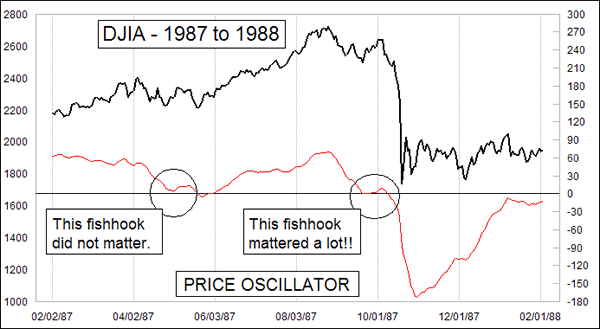Fishhook Rules
What are your rules for a fishhook? Does it apply to either a Price Oscillator or a Summation Index? Does it need to occur near zero, above or below zero level, smooth trend, etc.?
This is an excellent question you pose. I am not sure I can definitively provide all of the rules to the standard of testibility, but here goes.
A fishhook formation is named because of the shape of the indicator as it forms in the chart. They are important to us when they occur because the represent a moment of turmoil, and potentially of great energy about to be unleashed.
Fishhook formations occur in first derivative indicators like a Price Oscillator or Summation Index. The McClellan Oscillator is a second derivative indicator, in that it represents the slope of the Summation Index (remember college calculus?). As an aside, if you were to calculate a "Price Oscillator" from the raw A-D Line's values, you'd get the Summation Index, which is an interesting piece of math explanation, but does not help us trade.
A fishhook cannot occur when the subject indicator at a very high or very low (deeply negative) level. At extremes, a better explanation than typical "fishhook" behavior is more appropriate. Fishhooks are better when occur at or near neutral. Good ones are found about half-way down from a high level to neutral, when there is still a lot more room for prices to fall. The rally which failed in early October 1987 is the textbook example of this concept.

At its heart, a fishhook represents a failed attempt to reverse a trend. When a new downtrend starts, the bulls may make a half-hearted attempt to reverse course and get prices moving higher again. The fishhook depicts the failure of that effort. Inverted fishhooks also appear in the historical record, and have a bullish implication, but I would say that bearish fishhooks (on the way down) are the much more powerful and therefore worrisome type.
It is also worthy of note that not all fishhooks turn out to have the ominous meaning that the structure implies. Some just fizzle. In this respect, fishhooks are just like every other indicator or market phenomenon in that they are not perfect.
When we get around to writing the sequel to Patterns For Profit, we'll have to be sure to include a whole chapter on fishhooks.